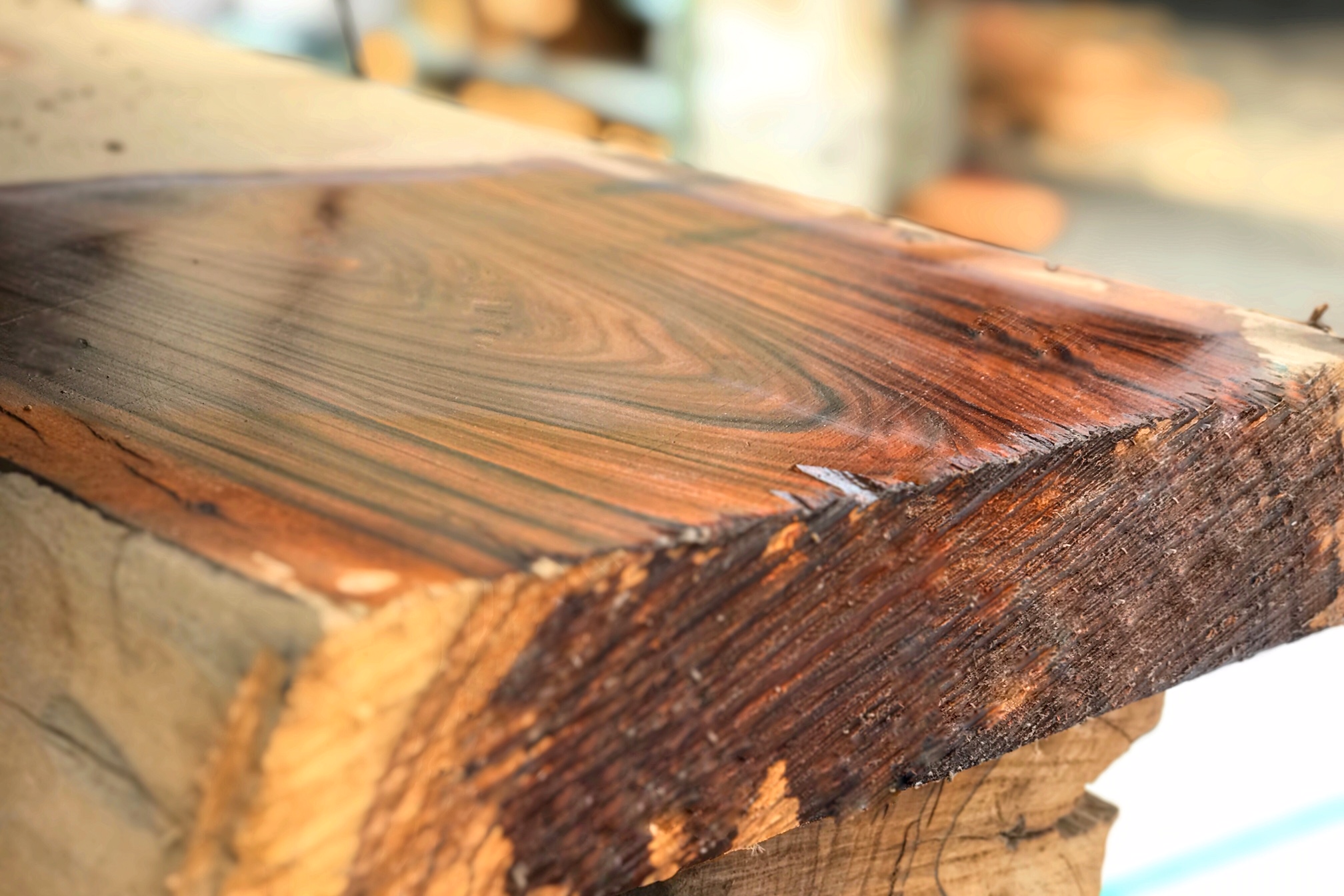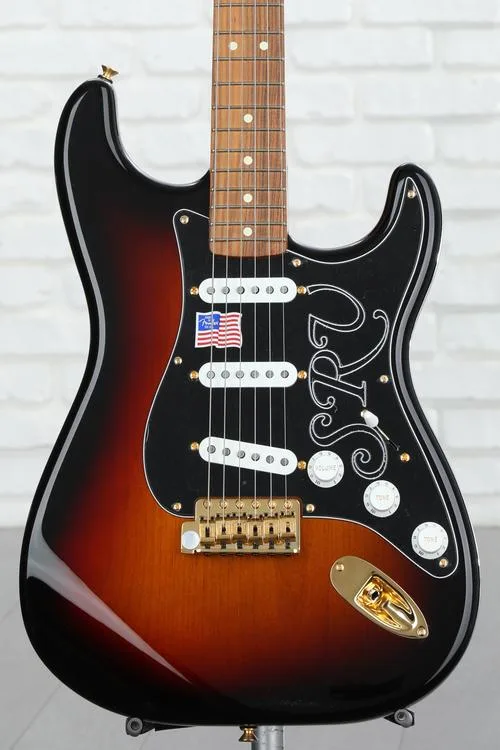The impact of fretboard tonewoods on tone and playability is a highly debated topic amongst guitar players. Typically divided among maple and rosewood lovers, guitarists nowadays use many other tonewoods that are equally as good. In this Pau Ferro Fretboard Guide, I will detail one of my favorite tonewoods used in modern guitar building, primarily to replace rosewood.
My Bottom Line Up Front: Pau Ferro Fretboards are resistant, smooth on the hand, and a good middle ground sonically between the bright Maple & warm Rosewood.
Pau Ferro makes for the best replacement for the now endangered Rosewood due to its many similarities. However, It’s not an inferior tonewood and is used in both affordable and premium instruments.
What is Pau Ferro?
Pau Ferro is a South American Exotic Tonewood with many other names. Bolivian Rosewoods and Santos Rosewoods are other names that indicate how similar Pau Ferro is to the Rosewood we are used to seeing on guitars.
This Tonewood became much more popular in recent years in guitar building, especially for fretboards. Unlike the now endangered Rosewood, Pau Ferro is a much more sustainable alternative that also goes at a lower price. Legendary companies like Fender are now using it extensively, and many others are following.

Pau Ferro is not a lesser quality Tonewood than Rosewood. It makes for a great replacement, yet it’s not identical. It’s brighter in color and harder than Rosewood with a tighter grain. Sonically, it contributes to the guitar’s overall tone.
Pau Ferro Fretboard guarantees the best possible tone and feel. As with most Tonewood-related topics, the difference lies in the player’s preference.
Pau Ferro Fretboard Pros
- It is widely available and a more sustainable choice for the environment
- Ads sonically with attack and snap balancing well warm sounding instruments
- It gives you many options of color, from light brown to dark
- It offers a friendly to the touch, smooth playing experience
Pau Ferro Fretboard Cons
- Your guitar fretboard might have either a brighter or darker color than expected when ordering online.
Pau Ferro Fretboard Tone
Pau Ferro stands right in between the warmth of rosewood and the attack of Ebony or Maple. There is just enough brightness to give some snap and articulation to the guitar tone of a very warm guitar.
It’s highly discussed how much the fretboard tonewood is part of the guitar’s overall tone. My argument is that the tone and style dictate the impact of the fretboard wood. If you always play with a high gain, the pickups numb fretboards and most of the body’s tonewoods.IF you play clean and with few effects, the tonewood contributes more to the guitar’s overall sound.
Overall you should not stress too much on the Fretboard tonewood if you’re happy after trying the guitar. Your ears and hand are the best tests a fretboard can go through.

Pau Ferro Fretboard Playability
The playability of a fretboard is the combination of good tonewoods, fretwork, and craftsmanship. You can’t have a good playing fretboard if one element fails to deliver. If all else is done right, the tonewood type affects how the neck feels.
A Pau Ferro Fretboard feels smooth and very slick. Your hand will flow nicely on the fretboard with the right fret size and neck profile. There are really no bad sides to Pau Ferro regarding how it feels on the hand, only preferences.
Is Pau Ferro a Good Replacement For Rosewood?
Rosewood has been the staple for electric guitarists who liked both the warm sound and dark look of the Tonewood. Every big company of the last century either used Rosewood or its bright-sounding and looking counterparts, Maple.
With Tonewoods getting endangered and more expensive, the closest alternative is, without a doubt, Pau Ferro. Both tonewoods have a similar look and, most importantly, feel very similar, almost identical feel when used on a fretboard. Apart from the apparent brighter brown color, other characteristics make it hard to tell from rosewood unless you know what to look for.
Both tonewoods are very strong and resistant to being affected by years of playing. Pau Ferro has a faster Attack and generally brighter tone than Rosewood; however, not as much as a Maple fretboard.
If you are used to playing only Rosewood fretboard like many players are, switching to Pau Ferro will be as effortless as possible. The only reason I can think of you might not like a Pau Ferro Fretboard is if you are exclusively into dark-looking fretboards.
If you are really into the all-dark Rosewood look, there are ways to darken your Pau Ferro Fretboard.
Guitars with Pau Ferro Fretboard
A fretboard is only as good as the guitar is. Even though it makes a difference in playability and tone, it won’t add too much to a bad guitar. Pau Ferro is used on many popular guitar models, some of which you probably thought used brighter Rosewoods.
Steve Ray Vaughan Signature Strat
The original SRV guitar inspires this legendary signature Strat model. It’s one of Fender’s most successful signature models and a fantastic instrument for rock, blues, etc.
The Pau Ferro fretboard is an essential ingredient not only of the only but of the tone. When you think about how snappy Steve’s sound was, it makes sense he preferred the brighter Pau Ferro to the warm Rosewood.
If you like Stratocasters, then this is the guitar to aim for. The only downside of it is that it’s very expensive and will require some investment.
Shortly before his tragic death in 1990, Stevie Ray Vaughan collaborated with Fender guitars to produce an Artist Series Stratocaster. Few guitarists have had as much impact on popular music as Stevie, except maybe Clapton, Beck, and Hendrix.
Fender Player and Player + Series

The Player series is Fender’s attempt to make its iconic models affordable while retaining the original tone. The Player + is the more advanced series of yet not too expensive instruments, great for advanced and professional players.
If you are after a Fender but are on a budget, these two series are what you should be after. The Player series could also be the best first Fender guitar you own, far more fitting than a Squier.
Both series have in common Pau Ferro Fretboard for most of their models, most likely to keep costs down and add to the typical Fender high-end sparkle.
The Player Series Stratocaster Pickups contain Alnico 5 magnetic pole pieces which provide rich and balanced bass response, punchy mid-range, and crystalline bell like highs with enhanced focus and dynamics.
SUHR Standard Plus
The SUHR Standard Plus is a top-tier modern instrument built with the best parts and luthiers..
This Super Strat Strat guitar is worth well over 3000$ but worth every dollar with its unparalleled versatility and playability. With an HSS pickup configuration, it’s for every music genre apart from very heavy music. In my opinion and experience, it’s one of the best modern guitars out there if you want one main instrument to cover everything you do.
The Pau Ferro Fretboard is not chosen randomly but adds to the tone and playability of this exceptional guitar.
There are multiple other examples of guitars of every price range that use Pau Ferro Fretboard. We are only going to see more of them in the future.
The Suhr Standard Plus, with its crisp lines, classic shape, and quality craftsmanship is the best in reliability and stability.
Pau Ferro Fretboard Alternatives
If you are looking for other Fretboard tonewoods, the most likely you will encounter are the following.
Pau Ferro vs Rosewood Fretboard

You should have a clear idea by now of how both tonewoods differ. I want to add that there are many types of Rosewood Fretboards, and you could find both affordable and very expensive fretboards for sale.
Pau Ferro Vs Maple Fretboard

The first difference you will immediately notice between the two fretboards is the color. The typical shiny bright yellow Maple look is unique to the Tonewood.
Maple is not as resistant as Pau Ferro or Rosewood and usually needs finishing before being ready for extended use. The finish is responsible for a slightly shiny look and for its smooth surface. On some occasions, the finish can feel slightly sticky and hinder playability when not done well.
Pau Ferro Fretboards are not finished, and you can feel some of the wood when playing but not negatively.
Sonically Maple is far brighter and with more attack than Pau Ferro. If you are after the typical Strat or Tele snap and brighter colors, you might prefer it over Pau Ferro.
Pau Ferro vs Ebony Fretboard

Ebony is the other tonewood apart from Rosewood that Pau Ferro could easily replace. They are both dark-looking, solid tonewoods with similar acoustic properties.
Many consider Pau Ferro as the halfway between Rosewood and Ebony, and they are right.
Ebony is usually solid black and gives a classy look to the instrument. Sound-wise, Ebony has a very clear and smooth sustain with more attack and brightness than Pau Ferro.
Pau Ferro is warmer sounding, yet not by much as the effect of the fretboard wood on the overall tone is little compared to the guitar’s body and pickups.
Pau Ferro vs Indian Laurel

Indian Laurel is another alternative to rosewood that makes for a sturdy and smooth fretboard. It’s darker than Pau Ferro yet similar tone-wise with a moderate brightness and attack to it.
Like Pau Ferro, Indian Laurel shares the same reputation as a replacement tonewood you will most likely find on affordable guitars.
The main reason behind that, like with Pau Ferro, is the sustainable nature. Nowadays, though, it’s being accepted more as being on pair with Rosewood when used on high-end guitars.
Pau Ferro Fretboard Guide FAQs
Question: How long does it take to wear out a fretboard?
Answer: What usually wears out the most are guitar frets. Whenever you pick up a vintage guitar that still has the original frets, most likely, they will be worn out in the place where they have been played most. Guitar fret can be worn out if used much in a few years or even 20 years if not used much.
On the other hand, fretboard wood wear takes much longer, and minor dents and holes can be fixed easily. Some players wear out the fretboard wood deliberately as they like its look.
Question: Should you oil a Pau Ferro fretboard?
Answer: Pau Ferro, Ebony, and Rosewood should be oiled with lemon or Almond oil every 6 months. Oil helps nourish the wood and clean out all the grime stacked up over countless hours of playing. However, you should not overuse oil as it would damage the fretboard.
Question: How do I clean a Pau Ferro fretboard?
Answer: Pau Ferro fretboards are not lacquered, making them prone to collecting dirt. Scrape the dirt off them using fine steel wool or similar not to rough sandpaper. Be careful to apply slight pressure. You can read the full detailed guide for more information.
Final Thoughts on Pau Ferro Fretboards
If you like dark-looking fretboards, you will enjoy any Pau Ferro fretboard like a Rosewood or Ebony one.
If you need to change your existing fretboard or wondering what fretboard should your new guitar have, I recommend you take advantage of the affordable and sustainable nature of Pau Ferro.
- Do you Actually Need a Trembucker? Humbucker vs Trembucker - May 11, 2024
- Best Headphones for Guitar Amp Guide - April 23, 2024
- Takamine vs Martin Comparison – US-Made Legacy Against Japanese Precision - March 30, 2024






